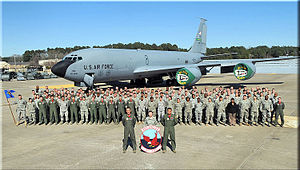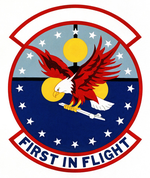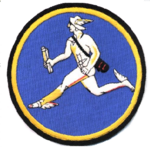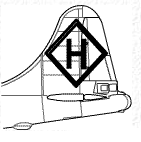911th Air Refueling Squadron
 | |
|---|---|
 The 911th Air Refueling Squadron | |
| Active | 1917–1919; 1923–1933; 1935–1946; 1958–2007; 2008 – present |
| Country | |
| Branch | |
| Role | Air Refueling |
| Size | 260 persons[1] |
| Part of | Air Mobility Command |
| Garrison/HQ | Seymour Johnson Air Force Base, North Carolina |
| Motto(s) | First in Flight |
| Engagements | Pacific Ocean theater of World War II |
| Decorations | Distinguished Unit Citation Air Force Outstanding Unit Award |
| Insignia | |
| 911th Air Refueling Squadron emblem[a][2] |  |
| 911th Air Refueling Squadron emblem[b][3] |  |
| Patch with old 911th Air Refueling Sq emblem |  |
| Patch with 411th Bombardment Squadron emblem[c][4] |  |
| 411th Bombardment Squadron Tail Marking (Pacific) |  |
The 911th Air Refueling Squadron is part of the 305th Operations Group, and is stationed at Seymour Johnson Air Force Base, North Carolina. The squadron was the Air Force's first active duty squadron under the command of a reserve wing. In October 2016, the 911th, formerly geographically separated from the 6th Air Mobility Wing at MacDill Air Force Base, Florida and operated as the active duty associate to the 916th Air Refueling Wing, became the first "I-Wing" or Integrated Wing. In July 2020, it was reassigned to the 305th Operations Group at the McGuire AFB entity of Joint Base McGuire–Dix–Lakehurst, New Jersey.
The squadron is one of the oldest in the United States Air Force. Its origins date to 15 May 1917, when it was organized at Kelly Field, Texas. The 21st Aero Squadron served in France as part of the 3d Aviation Instruction Center, American Expeditionary Forces, as a pilot training squadron during World War I.
The squadron was activated as the 21st Observation Squadron in 1923, but received few, if any, personnel before being disbanded in 1933. In 1935 a new 21st Observation Squadron was organized at Langley Field, Virginia.[d] In 1939, it moved to Florida and began to fly Neutrality Patrol missions over the adjacent waters.
After the attack on Pearl Harbor it flew antisubmarine patrols in the Gulf of Mexico and off the Atlantic Coast. It then became a heavy bomber training unit until 1999. In 1944 it converted to Boeing B-29 Superfortresses and saw combat in the Pacific during World War II, where it was awarded a Distinguished Unit Citation for its actions during the strategic bombing campaign against Japan.
It became part of Strategic Air Command (SAC) during the Cold War, maintaining a portion of its strength on alert. It frequently deployed a portion of the unit to support SAC operations, including combat operations in Southeast Asia. Members of the squadron participated Operation Enduring Freedom and Operation Iraqi Freedom. In 1991 it transferred to Air Combat Command as the United States Air Force reassigned and combined units to maintain a single wing on each base. It continued to support contingency operations after transferring to Air Mobility Command until it was inactivated in 2007.
Today, the squadron operates the Boeing KC-46 "Pegasus" aircraft conducting air refueling missions worldwide as an active component of the Air Force's first Integrated Wing, flying the aircraft of the reserve 916th Air Refueling Wing.
- ^ Rizzo, Brandon (27 September 2007) [6 September 2007]. "BRAC changes on the horizon for North Carolina refueling wing". 916th Air Refueling Wing Public Affairs. Archived from the original on 23 February 2014. Retrieved 19 March 2014.
- ^ Lahue, Melissa (28 November 2022). "Factsheet 911 Air Refueling Squadron (AMC)". Air Force Historical Research Agency. Retrieved 25 December 2022.
- ^ Endicott, p. 889
- ^ Maurer, Combat Squadrons, pp. 502–503
Cite error: There are <ref group=lower-alpha> tags or {{efn}} templates on this page, but the references will not show without a {{reflist|group=lower-alpha}} template or {{notelist}} template (see the help page).
